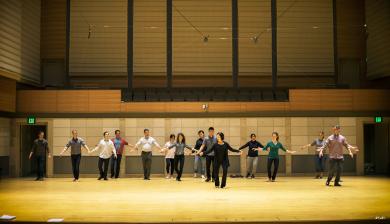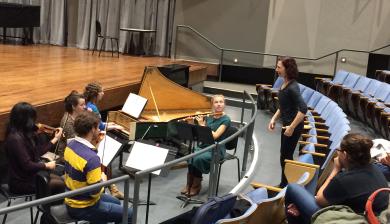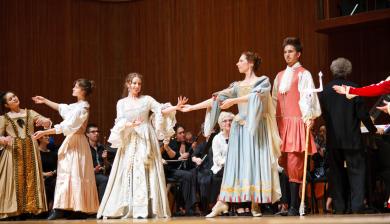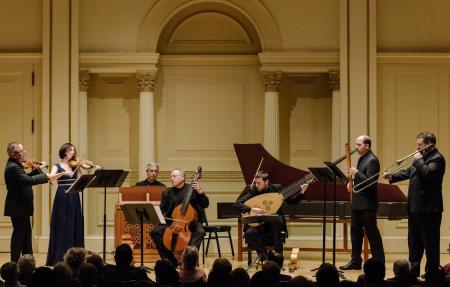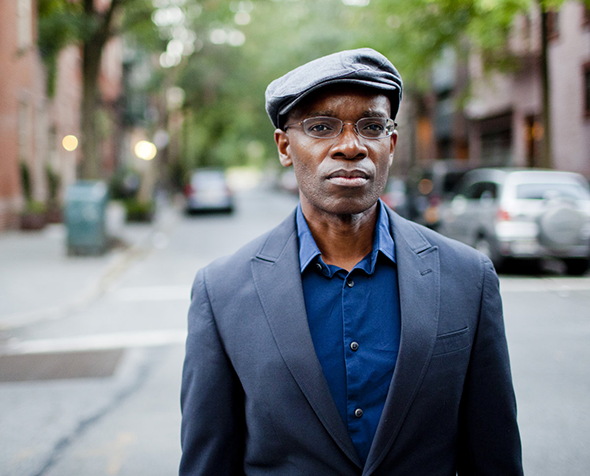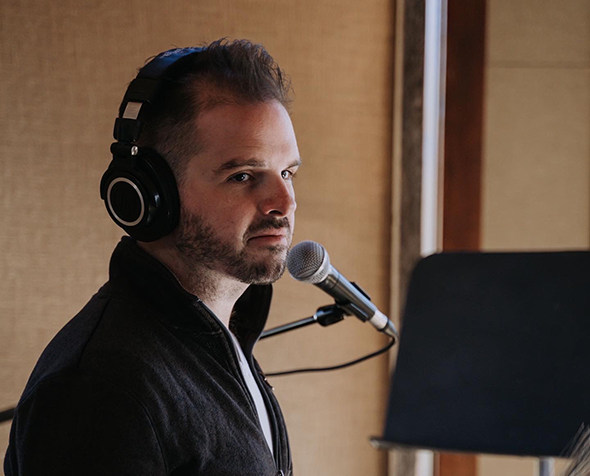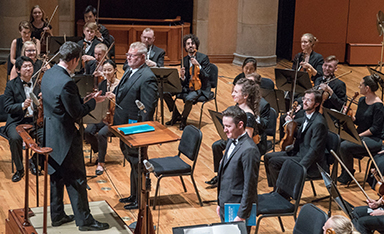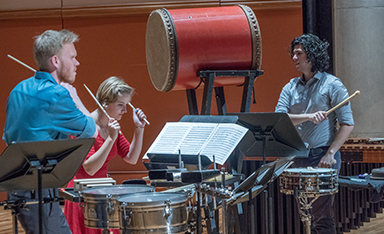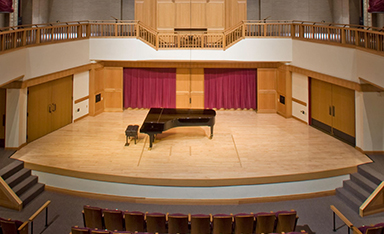Alumna Profile: Julie Andrijeski

Julie Andrijeski: Bridging Music, Dance, and History
In the field of historical performance practice, Julie Andrijeski (BM ’85) is a luminary whose career is a testament to hard work and passion, with a significant dose of serendipity. With roots in Boise, Idaho, her journey from a young violinist to a renowned figure in the world of Baroque music and dance was shaped in part by a rich undergraduate experience at the Lamont School of Music.
Julie demonstrated musical talent at a young age when, according to her mother, she was able to pick out tunes on the piano. She started Suzuki violin with her first teacher, Gladys Shook, at the local YWCA—where she was the only student to show up for classes—and soon advanced to being concertmaster of the all-City honor orchestra. Alongside her musical studies, and with the encouragement of her mother who was a dance teacher, she also took up ballet and tap dance.
In high school, Julie continued her violin lessons with Lois Wuertz, who had a former student who attended the University of Denver Lamont School of Music. Julie had never heard of DU or Lamont but applied based on this recommendation. She was delighted to be accepted with a nice scholarship, to boot, and enrolled in the Fall of 1980.
“It was a brand-new world for me,” she recalled of her time at Lamont. “I was enamored by the level of the students around me, and thrilled that I could be surrounded by all these fellow musicians. Out of sheer luck, my dorm next-door neighbor happened to be a violinist as well, and we’re friends to this day.” She studied violin with James Maurer and played in the orchestra under Vince LaGuardia, both of whom introduced her to a wide repertoire and were “a joy to play for.”
As a junior, Julie took advantage of DU’s robust study abroad program and spent a year in Vienna. “It changed my life,” she said. “For one thing, it taught me to love opera!” Her time in Vienna, on top of her broader experience as a music major at Lamont, inspired her to keep playing music and to continue to seek out opportunities to make it an even larger part of her life.
Further academic pursuits led Julie to Northwestern University, where she studied with Edgar Muenzer and completed her Master of Music in one year. She was just about ready to start her professional studies at Northwestern when a fateful call came from Linda Cerone at the Cleveland Institute of Music (CIM).
“Linda said “I’ll take you!” about a week before I was going to start classes at Northwestern,” recalled Julie. “I kind of just fell into opportunities like this all along the way, but they were really wonderful opportunities!” She promptly moved to Cleveland and began her Doctor of Musical Arts in violin performance at CIM.
Through CIM’s Joint Music Program with Case Western Reserve University (CWRU), Julie took a class called Introduction to Historical Performance Practice with Ross Duffin, and finally discovered her true calling in Baroque music. Duffin suggested that she play in the school’s baroque orchestra as well as attend Oberlin’s Baroque Performance Institute. At Oberlin she also happened upon Baroque dance, and from that point on, she sought out any and all opportunities to study and perform both baroque dance and music. This intricate marriage of these two art forms defines her unique style, and she’s been teaching historical violin and dance ever since.
When asked what exactly drew her to Baroque music, Julie explained, “When I first started exploring this music, I realized that you could play music that nobody had ever played before and interpret it in your own style—knowing the basics of how to do that, of course. You’re not necessarily the virtuoso on the stage, but you are playing this piece to connect with the emotions of the audience. It can say so much with so little. The research aspect was also very appealing to me, going into various libraries (and now online) to dig through music that no one had ever seen before.”
While still working on her joint CIM/CWRU DMA, Julie won a job with Chatham Baroque in Pittsburgh. She remained there for a decade. She eventually earned her DMA in Historical Performance Practice in 2006, and the following year Ross Duffin reached out to her with an opportunity to fill a one-year teaching position at CWRU: “They convinced me to stay after that, and I’ve been here 14 years!”
Julie rose to the position of Head of Historical Performance Practice (Duffin’s former position) at CWRU, where she is also the Artistic Coordinator of HPP Ensembles. She directs music and dance ensembles and seminars in historical performance at CWRU and also teaches baroque violin and stage movement at CIM. Also at CIM, she is Director of Baroque Ensembles and violin faculty in their historical performance program. Julie also teaches at various summer workshops including the Baroque Performance Institute at Oberlin, where she gained such a keen passion for the genre so early in her journey.
Outside of academia, she is Artistic Director and Concertmaster of the Atlanta Baroque Orchestra, co-directs Quicksilver, and frequently plays and records with Apollo’s Fire, Les Délices, and the Boston Early Music Festival Orchestra.
Reflecting on how Baroque music fits into the larger classical music industry, Julie noted that there is a dichotomy between the East and West Coast scenes, with it being treated less as a “niche” genre out East, including in Cleveland. She attributes this in part to the esteemed historical performance programs at Juilliard and CWRU, whose graduates are spreading the style across the U.S. Julie has noticed that more and more major orchestras are programming Baroque works and bringing in specialized conductors. She sees smaller early music groups who are combining Baroque with other traditions or doing newly-composed works on historical instruments. “People are always thinking of new things to do, making breakthroughs in the field,” she said. “And here I am, all these years later, after being told in 1988 that this would just be a fad!”
Zoe Weiss, now an Assistant Professor of Musicology at Lamont, had the chance to learn from Julie at the Baroque Performance Institute early in her education. She said, “I still recall musical epiphanies I had doing a Baroque dance workshop with her at Oberlin twenty years ago! Julie’s prolific accomplishments as a performer, teacher, and scholar of music offer current students an inspiring view of the many directions you can go with a Lamont education.”
Through Julie’s unwavering commitment to historical authenticity and artistic innovation, she has not only redefined the boundaries of Baroque music but also inspired countless individuals to embark on their own musical odyssey.
